
5 ways to save on auto expenses to offset gas prices
With gas prices continuing to rise, it’s more important to find ways to save at the pump and for your auto expenses. According to a CNBC article, U.S. households are spending an estimated $5,000 a year on gas.
If you’re trying to find some creative ways to save, here are some ways to help reduce your fuel consumption and driving costs, according to AAA.
Maintenance and repairs
When buying a car, look for models that offer the best fuel economy in their class. For most drivers, an optional larger and/or more-powerful engine is unnecessary.
- Maintain your car according to the manufacturer’s recommendations. Modern cars don’t need “tune-ups,” but regular service will ensure optimum fuel economy, performance, and longevity.
- Take your car to a repair shop as soon as possible if the “Check Engine” light comes on. This indicates a problem that is causing excessive emissions and likely reducing fuel economy.
- Keep tires properly inflated. Underinflation reduces fuel economy, but more importantly, tires low on air degrade handling and braking, wear more rapidly, and can overheat and blow out.
On the road
- Slow down and drive the speed limit. On the highway, aerodynamic drag causes fuel economy to drop off significantly as speeds increase above 50 mph.
- Avoid “jackrabbit” starts and hard acceleration. These actions greatly increase fuel consumption.
- Avoid extended idling to warm up the engine, even in winter. It’s unnecessary and wastes fuel.
- Avoid prolonged idling in general. If your car will be stopped for more than 60 seconds, shut off the engine to save fuel. Many newer cars have automatic engine stop-start systems that do this.
- When driving in town, adjust your speed to “time” the traffic lights. This reduces repeated braking and acceleration that consume additional fuel.
- When approaching a red light or stop sign, take your foot off the gas early and allow your car to coast down to a slower speed until it is time to brake.
- Accelerate smoothly with light to moderate throttle. This allows the automatic transmission to upshift into higher gears sooner, reducing engine rpm and saving fuel.
- Use cruise control to help maintain a constant speed and save fuel. However, never use cruise control on slippery roads because a loss of vehicle control could result.
Don’t waste fuel
- Minimize your use of air conditioning. Even at highway speeds, open windows have less effect on fuel economy than the engine power required to operate the air conditioning compressor.
- Plan ahead to accomplish multiple errands in one trip, and whenever possible travel outside high-traffic times of the day.
- If you own more than one car, use the most fuel-efficient model that meets the needs of any given journey.
Other tips and tricks
- In hot weather, park in the shade or use a windshield sunscreen to lessen heat buildup inside the car. This reduces the need for air conditioning (and thus fuel) to cool down the car.
- Remove unnecessary and bulky items from your car. It takes more fuel to accelerate a heavier car, and the reduction in fuel economy is greater for small cars than for larger models.
- Minimize your use of roof racks and remove special carriers when not in use. On the highway, even an empty bike, canoe or ski rack can reduce fuel economy, and a loaded rack or car-top container will have a major effect on gas mileage.
- AAA research has found that unless premium fuel is recommended or required by your car’s manufacturer, it provides no added benefit. Motorists should refer to their vehicle’s owner’s manual to check which type of gasoline is recommended for their engine.
Other money-saving ideas
Along with fuel-saving ideas for your vehicle, try some of these tricks:
- Track your local prices to find the best gas station.
- Get money back from gas credit cards and fuel rewards programs.
- Pay for gas with cash.
- Try a membership for discounted gas prices.
- If possible, walk or bike more.
- Use public transportation.
- Fill up your vehicle more often, but you’ll buy less gas.
- Take fewer shopping trips.
- Work from home if you can do your job remotely.
- Don’t wait until your tank is almost empty.
- Avoid gas stations that charge more.
The information in this article was obtained from various sources not associated with Adirondack Bank. While we believe it to be reliable and accurate, we do not warrant the accuracy or reliability of the information. Adirondack Bank is not responsible for, and does not endorse or approve, either implicitly or explicitly, the information provided or the content of any third-party sites that might be hyperlinked from this page. The information is not intended to replace manuals, instructions or information provided by a manufacturer or the advice of a qualified professional, or to affect coverage under any applicable insurance policy. These suggestions are not a complete list of every loss control measure. Adirondack Bank makes no guarantees of results from use of this information.
Source: https://gasprices.aaa.com/news/fuel-saving-tips/; https://www.cnet.com/personal-finance/as-gas-prices-soar-try-these-10-ways-to-save-money-at-the-pump/; https://money.com/people-combatting-high-gas-prices/; https://www.moneycrashers.com/how-to-save-money-on-gas/

